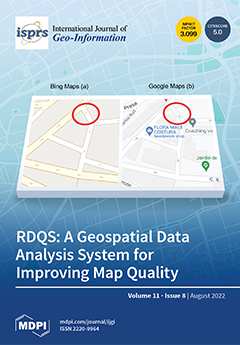Open AccessArticle
RDQS: A Geospatial Data Analysis System for Improving Roads Directionality Quality
by
Abdulrahman Salama, Cordel Hampshire, Josh Lee, Adel Sabour, Jiawei Yao, Eyhab Al-Masri, Mohamed Ali, Harsh Govind, Ming Tan, Vashutosh Agrawal, Egor Maresov and Ravi Prakash
Viewed by 2594
Abstract
With the increasing availability of smart devices, billions of users are currently relying on map services for many fundamental daily tasks such as obtaining directions and getting routes. It is becoming more and more important to verify the quality and consistency of route
[...] Read more.
With the increasing availability of smart devices, billions of users are currently relying on map services for many fundamental daily tasks such as obtaining directions and getting routes. It is becoming more and more important to verify the quality and consistency of route data presented by different map providers. However, verifying this consistency manually is a very time-consuming task. To address this problem, in this paper we introduce a novel geospatial data analysis system that is based on road directionality. We investigate our Road Directionality Quality System (RDQS) using multiple map providers, including: Bing Maps, Google Maps, and OpenStreetMap. Results from the experiments conducted show that our detection neural network is able to detect an arrow’s position and direction in map images with >90% F1-Score across each of the different providers. We then utilize this model to analyze map images in six different regions. Our findings show that our approach can reliably assess map quality and discover discrepancies in road directionality across the different providers. We report the percentage of discrepancies found between map providers using this approach in a proposed study area. These results can help determine areas needs to be revised and prioritized to improve the overall quality of the data within maps.
Full article
►▼
Show Figures





